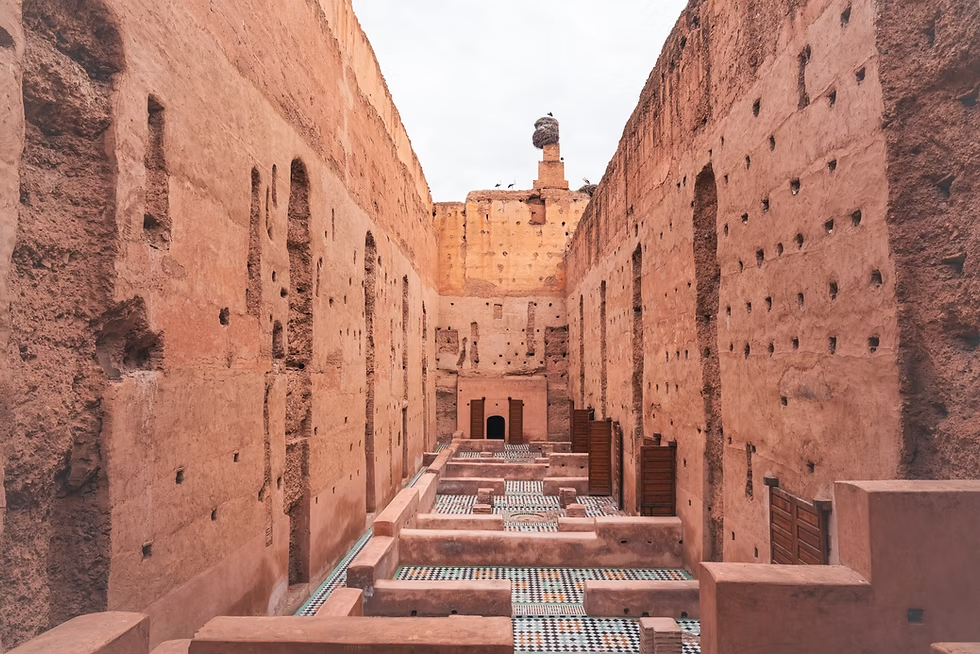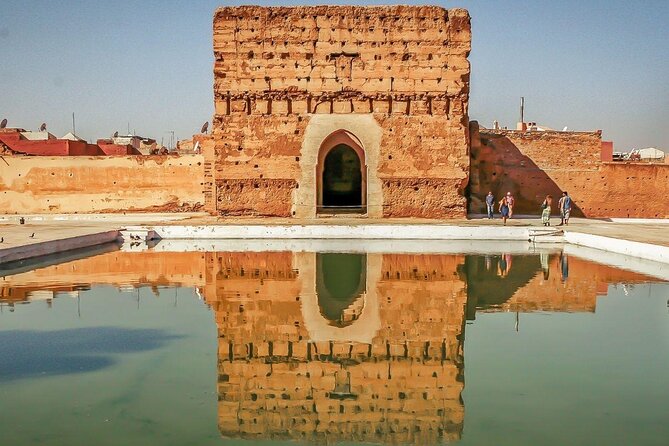Palais el Badi of Marrakech: Exploring Marrakech’s Magnificent Ruined Palace
Introduction: The Incomparable Palace
Palais el Badi of Marrakech, located in Marrakech, is one of Morocco’s most remarkable historical sites. Built in the 16th century by Sultan Ahmad al-Mansur of the Saadian dynasty, this once-grand palace is now an evocative ruin showcasing Morocco’s rich architectural heritage. Visitors can explore the vast courtyard, sunken gardens, and remnants of intricate designs that reflect the glory of its era
Standing amid the ochre-colored ruins of Palais el Badi of Marrakech, it’s easy to understand why this monument was once called “The Incomparable Palace.” As sunlight dances across ancient walls and reflects in long, rectangular pools, visitors are transported back to a time when this was the jewel of Marrakech a palace so magnificent that it left visitors speechless. Built during Morocco’s golden age, Palais el Badi of Marrakech stands today as a haunting testament to former glory, its crumbling grandeur telling stories of power, artistry, and ambition.
Whether you’re a history enthusiast, architecture lover, or simply seeking Marrakech’s most atmospheric spots, Palais el Badi of Marrakech offers a uniquely moving experience that connects you directly to Morocco’s illustrious past. This guide will walk you through everything you need to know to fully appreciate this remarkable monument during your visit to Marrakech.
Essential Information for Visitors
| Quick Facts | Details |
|---|---|
| Location | Ksibat Nhass, Marrakech Medina |
| Opening Hours | 9:00 AM – 5:00 PM (Daily) |
| Entrance Fee | 70 MAD (~$7 USD) |
| Best Time to Visit | Early morning (9-11 AM) or late afternoon (3-5 PM) |
| Time Needed | 1-2 hours |
| Nearby Landmarks | Saadian Tombs, Bahia Palace, Mellah (Jewish Quarter) |
A Journey Through Time: The Rich History of Palais el Badi of Marrakech
The Golden Age: Sultan Ahmad al-Mansur’s Vision
In 1578, the Saadian Sultan Ahmad al-Mansur secured a momentous victory against the Portuguese at the Battle of the Three Kings. Flush with ransom money and newfound prestige, he commissioned what would become one of North Africa’s most spectacular palaces. Palais El Badi was designed not just as a royal residence but as a bold statement of Morocco’s power and cultural sophistication during what historians consider the country’s golden age.
Construction & Grandeur: Materials, Influences, Anecdotes
Construction began in 1578 and took 25 years to complete, drawing on the finest materials from across the known world:
- Italian marble
- Gold from Sudan
- Indian onyx
- Jade from China
- Cedar wood from the Atlas Mountains
Contemporary accounts describe ceilings adorned with pure gold, floors of rare marble, and walls decorated with intricate zellij mosaics. The sultan famously asked an Italian merchant what he thought of his masterpiece, to which the merchant replied, “It is magnificent, but it will make a beautiful ruin.” This prophetic observation would eventually come true.
The “Incomparable”: What Made It So Special?
The palace earned its name “El Badi” (meaning “The Incomparable” or “The Marvelous”) for good reason. With over 360 lavishly decorated rooms surrounding a massive courtyard with reflecting pools, it represented the pinnacle of Islamic and Andalusian architectural traditions. The palace complex housed:
- A grand reception hall for diplomatic meetings
- Multiple private residential quarters
- Several hammams (bathhouses)
- Elaborate gardens
- Underground storage facilities
- A mosque
- The extraordinary minbar (pulpit) of the Koutoubia Mosque
Decline & Plunder: The End of an Era
The palace’s glory was short-lived. In 1659, Sultan Moulay Ismail of the succeeding Alaouite dynasty systematically dismantled Palais El Badi, stripping it of its precious materials to decorate his new capital in Meknes. This deliberate destruction took 12 years and left behind the skeletal structure we see today. What had once been the most splendid palace in North Africa became a monument to impermanence and the shifting fortunes of dynasties.
Rediscovery & Present Day
For centuries, the ruins stood neglected until archaeological interest revived in the early 20th century. Today, Palais El Badi operates as a cultural heritage site and museum, attracting visitors fascinated by its atmospheric remains and the stories they tell. The palace also serves as a dramatic venue for the annual Marrakech Folklore Festival and other cultural events.
Architectural Marvels: Deciphering El Badi’s Design
Layout & Key Areas
The palace follows a symmetrical design centered around a massive rectangular courtyard (135m × 110m) featuring:
- The Grand Courtyard: The heart of the palace with four sunken gardens and enormous reflecting pools that mirror the surrounding structures
- Central Pool: The main reflective basin measuring 90m × 20m
- Four Pavilions: Located at each corner of the courtyard
- The Summer Pavilion: At the northern end, marked by remaining tall walls
- Underground Chambers: Once used as dungeons and storage areas, now partially accessible to visitors
- Elevated Walkways: Offering panoramic views of the entire complex
- The Minbar Chamber: Housing the intricately carved wooden pulpit from the Koutoubia Mosque
Materials & Construction Techniques
While most of the precious materials were looted centuries ago, the remaining structures reveal sophisticated construction techniques:
- Pisé (rammed earth): The primary building material for walls, mixed with lime for durability
- Brick and Stone Foundations: Supporting the massive structure
- Remnants of Zellij Tilework: Visible in some areas, showing geometric Islamic patterns
- Cedar Beams: Traces remain in ceiling structures
Symbolism and Influences
The palace’s design represents a fusion of:
- Andalusian Architecture: Reflecting Moorish Spain’s influence through courtyard layout and water features
- Moroccan Traditions: Seen in the use of local materials and building techniques
- Ottoman Elements: In certain decorative motifs, showing the far-reaching connections of the Saadian dynasty
- Islamic Geometric Patterns: Applied throughout in keeping with religious artistic traditions
The extensive use of water in the design served both practical cooling purposes and symbolic representations of paradise in Islamic architecture.
What to See & Do at Palais El Badi Today: A Self-Guided Tour
The Grand Courtyard
Begin your exploration in the vast central courtyard, where you’ll immediately grasp the scale of El Badi’s ambition. The sunken gardens and rectangular pools would have been filled with fragrant orange trees and clear water, reflecting the surrounding architecture. Today, they provide perfect framing for photographs of the ruins.
The Underground Passages
Descend into the atmospheric subterranean chambers that once served as storage rooms and possibly dungeons. These cool, dimly lit spaces offer a stark contrast to the sun-drenched courtyard above and give insight into the palace’s functional aspects.
The Exhibition Rooms
Several rooms house small exhibitions of artifacts discovered during archaeological excavations, including pottery, coins, and architectural elements. Look for the informative displays about the palace’s history and construction techniques.
The Minbar of Koutoubia Mosque
Don’t miss the exquisite 12th-century wooden minbar (pulpit) from the Koutoubia Mosque, considered one of the masterpieces of Islamic art. This intricately carved cedar wood structure features remarkable geometric inlays and is displayed in a protected room within the palace complex.
The Storks of El Badi
Look up to spot numerous white storks nesting on the palace walls. These magnificent birds have made El Badi their home, adding to the romantic atmosphere of the ruins. Their enormous nests perched atop crumbling walls make for spectacular photographs, especially in the golden hour light.
The Panoramic Terrace
Climb to the elevated walkways for breathtaking views across the entire complex and the Marrakech medina beyond. This perspective helps you understand the layout of the palace and offers excellent photo opportunities, particularly at sunset when the ruins glow in the warm light.
Practical Guide for Your Visit
Getting There
Palais El Badi is located in the southern part of the Marrakech medina, near the Kasbah Mosque and the Saadian Tombs:
- On Foot: A 15-minute walk south from Jemaa el-Fnaa square
- By Taxi: Ask for “Palais El Badi” or “Badii Palace” (5-10 MAD from Jemaa el-Fnaa)
- By Calèche (Horse-drawn carriage): A scenic way to arrive, negotiate the price beforehand
- Guided Tour: Several companies offer guided historical tours that include Palais El Badi. Sahara Discovery, a reputable local travel company, offers excellent cultural heritage tours of Marrakech that include expert commentary on the palace’s history and architecture
Best Time to Visit
- Season: Spring (March-May) and fall (September-November) offer pleasant temperatures
- Time of Day: Early morning for fewer crowds and softer light, or late afternoon for the golden hour
- Avoid: Midday in summer months when temperatures can be extremely high
What to Bring
- Sun Protection: Hat, sunscreen, and sunglasses are essential as most areas are exposed
- Water: Bring a bottle as facilities are limited
- Comfortable Shoes: The terrain is uneven with many steps
- Camera: The photogenic ruins demand good photography equipment
- Small Backpack: To keep your hands free for climbing stairs and exploring
Accessibility Information
The palace has multiple levels with steps and uneven surfaces. Unfortunately, there are limited accommodations for visitors with mobility challenges. Some ground level areas are accessible, but many key features require climbing stairs.
Photography Tips for Palais el Badi of Marrakech

- Golden Hour Magic: Visit in the late afternoon when the setting sun bathes the ruins in warm, golden light
- Reflections: Capture the pools when they contain water, creating perfect mirror images of the ruins
- Scale: Include people in some shots to demonstrate the immense scale of the courtyard
- Details: Focus on architectural details, ancient construction techniques, and textured surfaces
- Panoramic Views: Use the elevated walkways for sweeping shots of the entire complex
- Wildlife: The resident storks make for excellent subjects, especially in flight or nesting
Palais el Badi of Marrakech in Context: Its Significance in Marrakech & Moroccan History
Palais el Badi of Marrakech represents a crucial chapter in Morocco’s history, marking the height of Saadian power and influence. Unlike the nearby Bahia Palace, which remains relatively intact with its elaborate decoration, El Badi offers a more evocative, melancholic experience. Its very emptiness speaks volumes about the transient nature of power.
The palace also provides important context for understanding Marrakech’s development as a imperial city. Together with the nearby Saadian Tombs, Palais el Badi of Marrakech helps visitors appreciate the Saadian dynasty’s architectural legacy and cultural sophistication.
Beyond the Walls: What’s Nearby Palais el Badi of Marrakech?
Make the most of your visit by exploring these nearby attractions:
- Saadian Tombs (5-minute walk): Elaborate royal burial ground discovered in 1917
- Kasbah Mosque (5-minute walk): Impressive 12th-century mosque (exterior only for non-Muslims)
- Mellah (Jewish Quarter) (10-minute walk): Historic neighborhood with distinct architecture
- Bahia Palace (15-minute walk): A well-preserved 19th-century palace with stunning decoration
- Place des Ferblantiers (5-minute walk): Square with metalworkers and casual cafés
Where to Eat Nearby
After exploring the palace, refresh yourself at one of these recommended spots:
- Café Clock: Creative Moroccan fusion food with a cultural center vibe
- La Famille: Garden restaurant serving fresh Mediterranean vegetarian meals
- KosyBar: Rooftop terrace with views and excellent cocktails
Extending Your Marrakech Experience
If you’re planning to explore beyond the city, Sahara Discovery offers a range of tours departing from Marrakech:
- Day Trips: Excursions to the Atlas Mountains, Essaouira coastal town, or Ouzoud Waterfalls
- Desert Experiences: 2-3 day tours to the Sahara Desert with camel trekking and desert camping
- Cultural Heritage Tours: Multi-day journeys combining historical sites with authentic cultural encounters
Their knowledgeable guides provide cultural context that enhances your understanding of historical monuments like Palais El Badi within Morocco’s broader heritage landscape.
Frequently Asked Questions about Palais El Badi
Is Palais El Badi worth visiting if I’m short on time in Marrakech? Yes, especially for history enthusiasts. If you must choose between palaces, Bahia Palace shows intact Moroccan craftsmanship, while El Badi offers atmospheric ruins and historical significance.
How much time should I allocate for visiting Palais el Badi of Marrakech ? One to two hours is ideal to explore the ruins thoroughly and enjoy the atmosphere.
Is there a guided tour available at Palais el Badi of Marrakech ? Official guides are available at the entrance for an additional fee. Alternatively, many city tours include the palace with knowledgeable guides. Sahara Discovery offers excellent guided tours that cover Palais el Badi of Marrakech along with expert historical context.
Can I visit Palais el Badi of Marrakech and the Saadian Tombs on the same day? Absolutely! They’re only a 5-minute walk apart and complement each other historically.
Are there any special events held at Palais el Badi of Marrakech ? The palace hosts the annual Marrakech Folklore Festival and occasional cultural performances, especially during summer evenings.
Can Palais el Badi of Marrakech be included as part of a larger Morocco tour? Yes, many tour operators include Palais el Badi of Marrakech in their Marrakech itineraries. Sahara Discovery offers comprehensive packages that combine Marrakech’s historical sites with excursions to destinations like the Atlas Mountains and Sahara Desert for travelers looking to explore more of Morocco.
Conclusion: The Enduring Magic of Palais el Badi of Marrakech
Walking through Palais el Badi of Marrakech is like stepping into a poem about time and forgotten splendor. What remains today the imposing walls, the reflecting pools, the panoramic views is just a shadow of its former glory, yet powerfully evocative. As the Italian merchant predicted centuries ago, it has indeed become “a beautiful ruin.”
In a city as vibrant and sensory as Marrakech, Palais el Badi of Marrakech offers a moment of contemplative calm. Here, as storks soar overhead and the Atlas Mountains shimmer in the distance, visitors can connect with Morocco’s golden age and ponder the impermanence of even the grandest human achievements.
When planning your Marrakech itinerary, give yourself time to experience this remarkable place fully not just as a quick photo opportunity, but as a journey into the heart of Morocco’s imperial past. The incomparable palace may have lost its gold and marble, but it has gained something perhaps more valuable: the poetic beauty that only time can bestow.
If you’re looking to explore beyond Marrakech, consider booking with Sahara Discovery, a trusted local tour operator that combines visits to historical sites like Palais El Badi with excursions to the Atlas Mountains, Essaouira, or the Sahara Desert. Their 1-day to multi-day tour packages provide an excellent way to experience Morocco’s diverse landscapes and cultural heritage with knowledgeable guides.
Have you visited Palais el Badi of Marrakech ? Share your experience in the comments below! And if you found this guide helpful, please share it with fellow travelers planning a trip to Marrakech.




